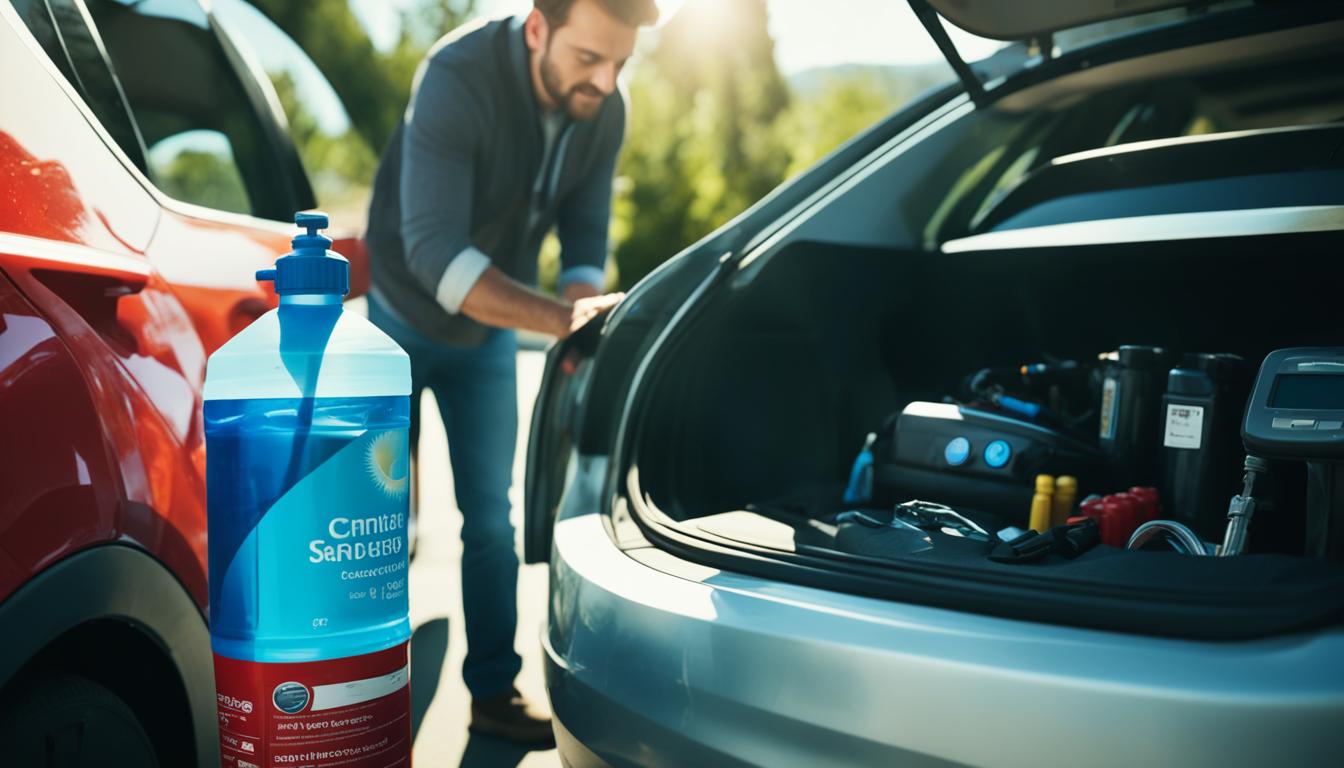
Effective Accident Response Plans for Fleet Managers

Preparing Your Car for a Safe Road Trip
Are you a parent of a teen who drives? It’s key to share with them essential tips for after a crash. Getting involved in your teen’s driving experience can reduce accidents. Here are some crucial tips to remember:
Key Takeaways
- Empower your teen with collision repair knowledge to enhance their safety and confidence on the road.
- Stay involved in your teen’s driving journey to help them navigate the challenges of the road and avoid collisions.
- Ease your teen’s anxiety by acknowledging their feelings and creating a supportive environment for learning to drive.
- Discourage phone use while driving and educate your teen about the dangers of distracted driving.
- Limit the number of passengers your teen can have in the car to minimize distractions and reduce crash risks.
Ease their Anxiety
Many teenagers are eager to drive but feel anxious about it. It’s key for parents to understand and address this fear. By talking about the stress of driving, teens may feel it’s okay to pull over when needed. This builds their confidence.
First-time driving is scary for many. Teens face the newness of it, the big responsibility, and the dangers. Talking about their worries with them helps calm their fears and guide them through.
Parents, let your kids know nervousness is common at first. Encourage them and say practice will make them more confident. But, it’s important not to push too hard. Pushing too much can make their anxiety worse.
Encouraging Safe Driving Habits
To calm your teen, teach them the rules of the road and traffic laws. Teach them defensive driving skills, like keeping a safe distance and watching for dangers.
Drive together in different conditions, like rain and city traffic. This experience will boost their confidence and ease their fears.
Also, think about a driving class for them. These programs offer thorough safety training and time driving for real.
Creating a Supportive Environment
Create a supportive vibe at home. Listen to your teen’s worries and let them know it’s normal to be nervous. Together, figure out ways to handle their fear.
Be patient as they learn. Don’t rush them, and offer both praise and pointers. This helps them get better at driving.
Show good driving habits yourself. Avoid getting upset at other drivers. Your calmness helps your teen feel more secure in the car.
It takes time to ease your teen’s driving fears. But, by being patient, supportive, and practicing, they’ll get there.
Discourage Phone Use While Driving
Distracted driving is very risky for young drivers. Using phones while driving is a big distraction. It’s vital for parents to make sure their teens know not to use phones while driving.
Distracted driving is dangerous for everyone on the road. We need to show our teens that this behavior is risky. Teaching them to keep their focus on driving is essential.
First, create a driving space that’s free from distractions for your teens. Tell them to silence their phones and put them away. This helps them avoid the urge to check messages. By teaching them good phone habits, they can stay focused on driving more easily.
Lead by Example
Parents must lead by example. Showing responsible phone use when driving is crucial. Avoid using your phone while driving to keep yourself and others safe. This sets a good example for your teen to follow.
Create Open Communication
Good communication is key in stopping phone use while driving. Talk to your teens about the dangers of using phones. Listen to their experiences and worries about driving. Encouraging open conversation helps clear up any misconceptions they might have.
Utilize Technology
Using technology can help reinforce safe driving. Many apps and phone features can block phone use while driving. Talk to your teen about these tools. They can help in choosing to focus on driving responsibly.
Encouraging responsible phone use and safe driving is important. It keeps our teens attentive and safe on the road. By teaching them the right habits, we cut down on accidents and support safer driving.
Limit the Number of Passengers
Having friends in the car is risky for teen drivers. This is more true when both the driver and the passengers are teens. Studies show the chance of a crash goes up when teens are driving with friends.
To make driving safer, it’s wise to limit how many friends your teen can have in the car. Clear rules about having friends ride along can make the road safer for everyone.
- Avoid Teen Passengers in the First Six Months: It’s best not to allow friends in the car for the first six months of your teen’s driving. This time is critical for them to learn to drive without friend distractions.
- Gradually Introduce Passengers: After your teen shows they’re driving well and being responsible, you can let them have friends in the car. But you should always make sure they’re ready and keep an eye on how they’re driving.
- Establish Clear Passenger Limitations: Make it very clear how many friends your teen can have in the car. This stops the car from getting too full, keeps distractions low, and makes driving safer.
By setting rules on how many friends can be in the car and watching this closely, you help your teen stay focused on driving. This makes the road safer for your teen and everyone else, too.

Make Seat Belts Mandatory
Keeping all drivers safe, especially teens, is very important. Making seat belts a must is a big step in this direction. If you teach your teen to always wear their seat belt, you’re starting a life-saving habit.
Seat belts are key in lowering injury seriousness during a crash. They keep you in place, stopping you from flying inside the car. They cut the chance of death by 45% in the front seats and 50% for serious injuries.
This rule isn’t just about your teen; it’s for their friends too. Research shows seat belts cut the risk of back seat injury or death by 73% in cars and 71% in light trucks. So, everyone should buckle up every time.
Showing and telling your teen about seat belt safety is critical. They’re more likely to wear their belt if they see you always do it. To stay safe, we must treat safety on the road as top priority, making sure our families are protected.
Why Seat Belts Are Essential:
- Seat belts save lives
- Reduce the severity of injuries
- Minimize the risk of ejection
- Protect all vehicle occupants
- Prevent passengers from being thrown around the vehicle
Limit Nighttime Driving
Driving at night can be tough, especially for new teen drivers. Less light and more risks can make it unsafe for everyone.
Parents, it’s key to keep your teen safe. Limit their night driving to help them get more confident first. You may want to ban it completely or set rules that work for your family.
Some states already have rules for new drivers, like not driving from 10 p.m. to 5 a.m. These rules are there to protect young drivers and cut down on night-time accidents.
By saying no to night driving, your teen escapes the extra risks of driving when it’s dark. This way, they have more daylight hours to learn and grow confident in their driving skills.

Setting limits on night driving can make things safer for your teen. It’s harder to see dangers, like people and road signs, when it’s dark. This can lead to more accidents.
Be sure you put safety first. Keep those night drives off-limits until your teen feels more sure about driving.
Set a Good Example
As a parent, our driving shapes how our teens drive. If we drive responsibly, we set a good example. This encourages our teens to drive the same way. Showing responsible actions on the road is key.
To set a good example, we must avoid getting distracted when driving. Texting and speeding distract us and can cause accidents. By staying focused and not using our phone, we teach our teens to do the same.
We should always wear our seat belts. Seat belts can save our lives and lower injury risks in accidents. By wearing our seat belts and making sure everyone else does, we show our teens this important habit.
It’s important to follow traffic laws without fail. This means sticking to speed limits, obeying signals, and driving courteously. It teaches our teens to be respectful and safe drivers.
Lastly, share your driving experiences and how you make good choices on the road. These stories can help your teens learn the value of safe driving habits.
Conclusion
Empowering your teen driver with tips for collision repair is key. This helps keep them safe and confident on the road. Easing their worries, saying no to phones while driving, and limiting friends in the car are important rules. Also, remind them to always buckle up and avoid driving at night.
Parents play a big part by setting a good example and staying involved. In case of an accident, getting quality repair services is crucial. At Miracle Body and Paint, we provide reliable collision repair. Our skilled team can fix everything from small dings to major damage.
As parents, our top priority is our teen’s safety on the road. By following these steps and staying involved, we help shape good driving habits. Let’s all do our part to keep our teens safe and ready for the road.



